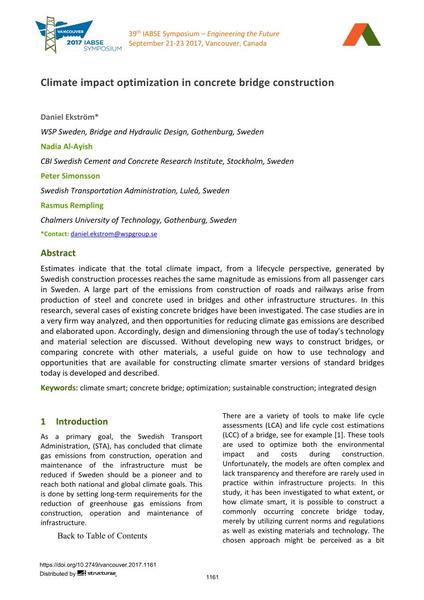Climate impact optimization in concrete bridge construction

|
|
|||||||||||
Détails bibliographiques
| Auteur(s): |
Daniel Ekström
(WSP Sweden, Bridge and Hydraulic Design, Gothenburg, Sweden)
Nadia Al-Ayish (CBI Swedish Cement and Concrete Research Institute, Stockholm, Sweden) Peter Simonsson (Swedish Transportation Administration, Luleå, Sweden) Rasmus Rempling |
||||
|---|---|---|---|---|---|
| Médium: | papier de conférence | ||||
| Langue(s): | anglais | ||||
| Conférence: | IABSE Symposium: Engineering the Future, Vancouver, Canada, 21-23 September 2017 | ||||
| Publié dans: | IABSE Symposium Vancouver 2017 | ||||
|
|||||
| Page(s): | 1161-1168 | ||||
| Nombre total de pages (du PDF): | 8 | ||||
| Année: | 2017 | ||||
| DOI: | 10.2749/vancouver.2017.1161 | ||||
| Abstrait: |
Estimates indicate that the total climate impact, from a lifecycle perspective, generated by Swedish construction processes reaches the same magnitude as emissions from all passenger cars in Sweden. A large part of the emissions from construction of roads and railways arise from production of steel and concrete used in bridges and other infrastructure structures. In this research, several cases of existing concrete bridges have been investigated. The case studies are in a very firm way analyzed, and then opportunities for reducing climate gas emissions are described and elaborated upon. Accordingly, design and dimensioning through the use of today’s technology and material selection are discussed. Without developing new ways to construct bridges, or comparing concrete with other materials, a useful guide on how to use technology and opportunities that are available for constructing climate smarter versions of standard bridges today is developed and described. |
||||
